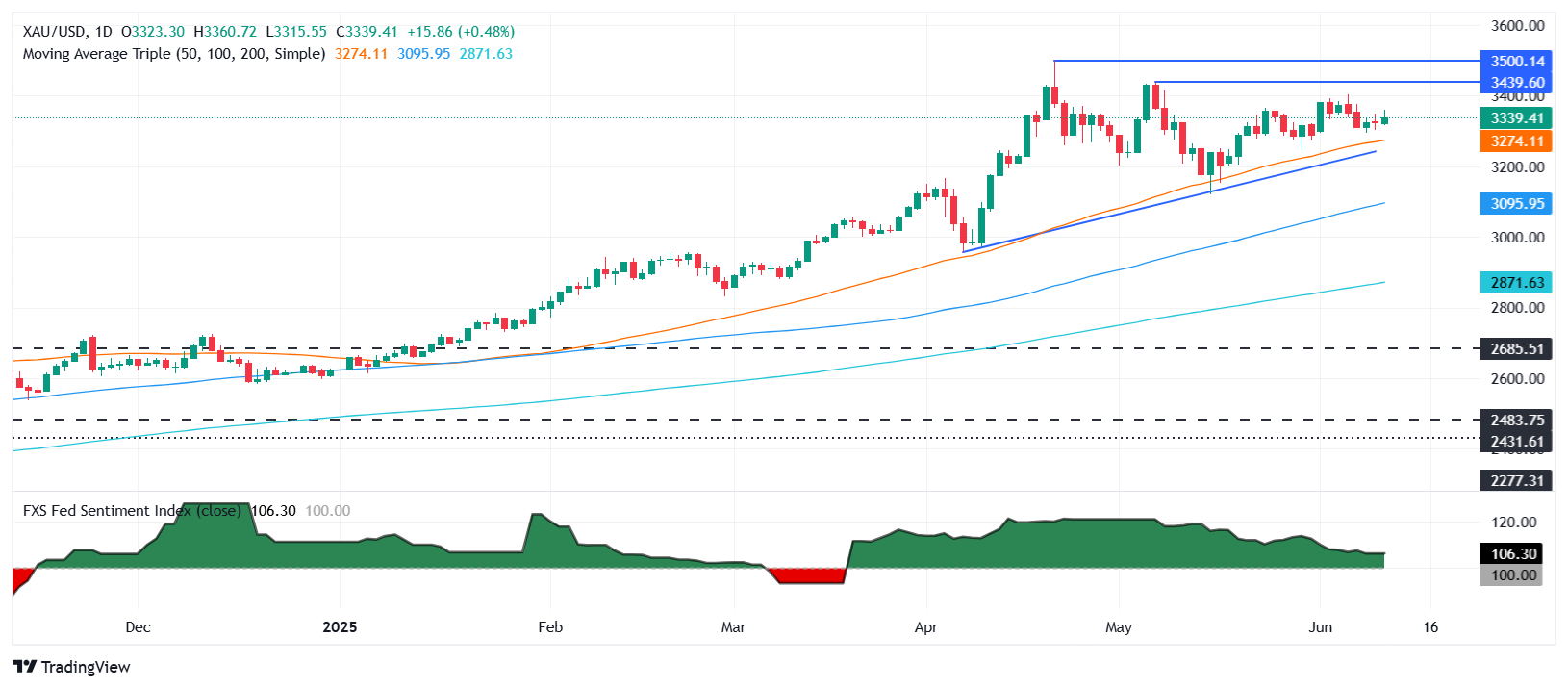- XAU/USD briefly hit $3,360 before paring gains and now trades near $3,320.
- US May CPI undershoots forecasts, lifting hopes for Fed easing in September.
- US-China trade talks show progress, but approval is still pending from top leaders.
Gold prices posted modest gains of over 0.22% on Wednesday as the latest inflation report in the United States (US) revealed that prices are cooling. Hence, investors increased their bets that the Federal Reserve (Fed) would resume its easing cycle in September. The XAU/USD trades at $3,327.
May’s Consumer Price Index (CPI) in the US provided an opportunity for Gold buyers. The print dipped compared to April’s data, and Bullion prices spiked toward a daily peak of $3,360 – in the headline – before erasing those gains.
Uncertainty around negotiations between the US and China will most likely keep Gold prices higher. Although US Commerce Secretary Howard Lutnick said that they’ve reached a framework to implement the Geneva Consensus, it is pending approval from US President Donald Trump and his counterpart Xi Jinping.
At the same time, the Chinese Vice Commerce Minister Li Chenggang said that talks “involved in-depth exchanges and communication had been rational and candid.” He added that he will report on the framework to leaders and expects that the progress could increase trust between the two countries.
Traders’ focus shifted to the release of the Producer Price Index (PPI) figures and jobs data. The latest ISM Purchasing Managers Index (PMI) surveys showed that input prices for companies had risen. Although May’s CPI data was positive, analysts suggest that households are yet to feel the impact of tariffs.
Daily digest market movers: Gold holds firm as the Greenback, US yields plunge
- The weakness of the US Dollar might keep Gold prices underpinned. The US Dollar Index (DXY), which tracks the value of the Dollar against a basket of peers, falls 0.44% to 98.61, reaching four-day lows.
- US Treasury yields are collapsing; The US 10-year Treasury yield has dropped five basis points (bps) to 4.42%. US real yields followed suit, falling by five basis points to 2.13%, boosting Bullion‘s advance.
- US inflation rose less than expected in May, with headline CPI up 2.4% YoY, below the 2.5% forecast but slightly above April’s 2.3%. The Core CPI remained steady at 2.8% YoY, matching the previous month’s figure and indicating persistent yet stable underlying price pressure.
- Geopolitical tensions remain high as US President Trump told Fox News that Iran is becoming much more aggressive in nuclear talks. The Iranian Foreign Minister said, “As we resume talks on Sunday, it is clear that an agreement that can ensure the continued peaceful nature of Iran’s nuclear program is within reach — and could be achieved rapidly.”
- Money markets suggest that traders are pricing in 47.5 basis points of easing toward the end of the year, according to Prime Market Terminal data.

Source: Prime Market Terminal
XAU/USD technical outlook: Gold price consolidates below $3,400
Gold price remains upwardly biased, but price action over the last two days indicates that buyers are reluctant to drive the spot price above $3,400. The Relative Strength Index (RSI) shifted flat near its neutral line, further confirmation of a trendless market.
For a bullish continuation, XAU/USD needs to climb above $3,350 to challenge $3,400. Further strength lies in $3,450 and the all-time high (ATH) at $3,500.
Conversely, if Gold slumps beneath $3,300, it opens the door to test key support levels, such as the 50-day Simple Moving Average (SMA) at $3,269. Below that level lies the April 3 high-turned-support at $3,167.

US-China Trade War FAQs
Generally speaking, a trade war is an economic conflict between two or more countries due to extreme protectionism on one end. It implies the creation of trade barriers, such as tariffs, which result in counter-barriers, escalating import costs, and hence the cost of living.
An economic conflict between the United States (US) and China began early in 2018, when President Donald Trump set trade barriers on China, claiming unfair commercial practices and intellectual property theft from the Asian giant. China took retaliatory action, imposing tariffs on multiple US goods, such as automobiles and soybeans. Tensions escalated until the two countries signed the US-China Phase One trade deal in January 2020. The agreement required structural reforms and other changes to China’s economic and trade regime and pretended to restore stability and trust between the two nations. However, the Coronavirus pandemic took the focus out of the conflict. Yet, it is worth mentioning that President Joe Biden, who took office after Trump, kept tariffs in place and even added some additional levies.
The return of Donald Trump to the White House as the 47th US President has sparked a fresh wave of tensions between the two countries. During the 2024 election campaign, Trump pledged to impose 60% tariffs on China once he returned to office, which he did on January 20, 2025. With Trump back, the US-China trade war is meant to resume where it was left, with tit-for-tat policies affecting the global economic landscape amid disruptions in global supply chains, resulting in a reduction in spending, particularly investment, and directly feeding into the Consumer Price Index inflation.
